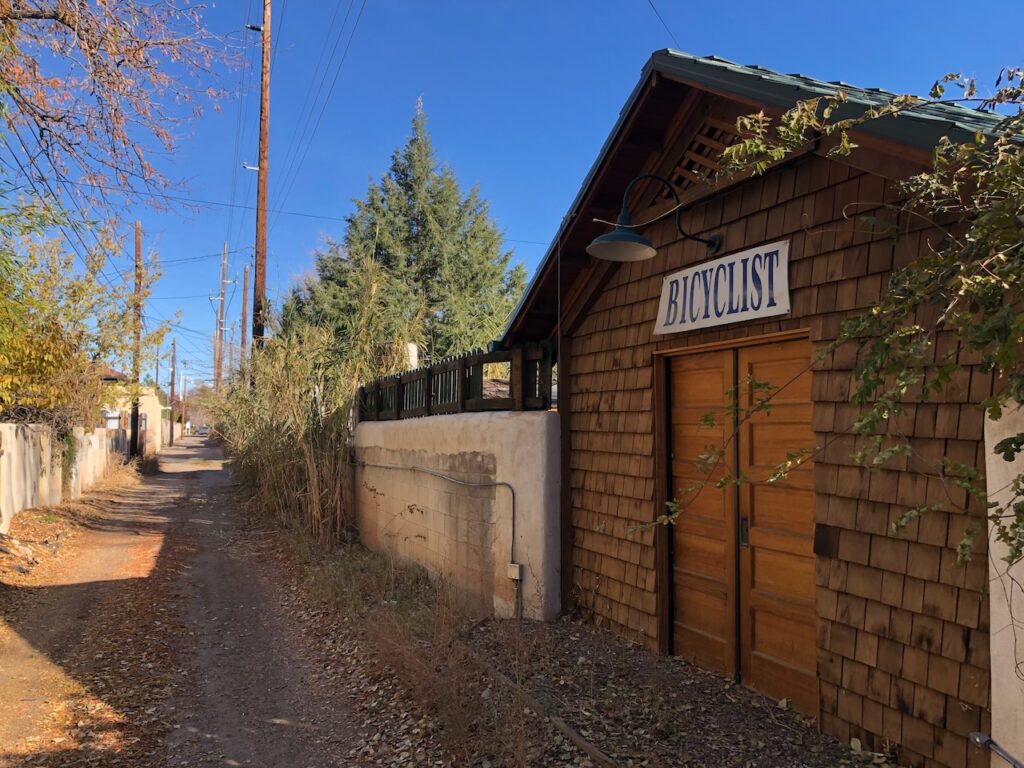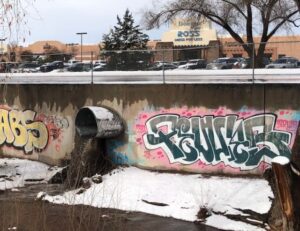
The alley behind Aldo Leopold’s house. November 2024, by John Fleck
There’s an alley off Albuquerque’s Central Avenue, old Route 66, between the Southwest Capital Bank and St. John’s Thrift Store. You can’t go down the alley on Google Street View. Google Street View mostly doesn’t go down alleys. Alleys mostly don’t have names. You have to go there for yourself.
Down past the “Drug Free Zone: Purchase or Sale of Drugs in this Area is a Felony” sign, past the house with the backyard pond with the lovely sound of tinkling water, past rogue bamboo, past the shed with the big sign that reads “Bicyclist” above the door, you’ll get to Aldo Leopold’s house.
In her book How to do Nothing, a meditation on the attention economy (thanks R!), the writer and artist Jenny Odell talks about “the ability not just to withdraw attention, but to invest it somewhere else, to enlarge and proliferate it, to improve its acuity.”
I find alleys to be excellent tools in this pursuit.
Arroyo Mascaras

Arroyo Mascaras, Santa Fe, New Mexico, Decembeer 2023. By John Fleck
On the south bank of the Arroyo Mascaras in Santa Fe, New Mexico, is a foot path that you get to by crossing a pedestrian bridge from the old De Vargas Mall.
L and I had rented a casita a few blocks to the south last winter, taking a break. I packed my foldable bicycle, and we both brought piles of books. We had no plans other than the suggestions offered by the things we had carried.
It snowed.
I found my way to the Arroyo Mascaras path by accident, entering what historian and photographer John Stilgoe calls a “secret corridor” – one strand of the web of paths, formal and informal, connecting parking lots and slipping through back alleys of a city.
The secret corridor proves an amazing fast shortcut to any explorer determined to brush aside low-hanging branches and to risk broken glass and rusted wire. And it offers the probing and poking explorer another view of the chrome-and-glitter commercial strip, even of the regional mall, for it makes clear the stealth with which change comes.
From the new path that opened before me, I could look back on the concrete wall bordering the arroyo, elegantly tagged by Santa Fe’s graffiti artists.
In 2013, the municipal government of Bogota, Colombia approved “responsible and artistic graffiti” in public spaces, and promoted state-sponsored murals. This prompted debates about the meaning of the art form, so rooted in a culture of oppositional place-making. It was the anthropologist Mary Douglas who defined “dirt” as “matter out of place.” This is foundational in understanding graffiti. Its meaning arises from the tension between those who think it doesn’t belong there, and those who think it does.
Stilgoe is a fan of secret corridors because you see stuff like this, and think stuff like this.
Alleys are great places to think about matter out of place.
The scrawling on the walls became more chaotic the deeper we moved into the tunnel. The unspoken rules that once governed canvas boundaries no longer apply; borders have collapsed, and pieces are free to exist in any patch of grey concrete their creators can find, or even on top of another artist’s work. It raises several questions: How can spatial freedom co-exist with respect for another person’s space? Is seniority alone a worthy basis for earning somebody’s respect?
That’s from Aaron Cantuu’s 2018 piece in the Santa Fe Reporter. Cantuu found his way to the Arroyo Mascaras too.
Aldo Leopold’s Albuquerque
When Aldo Leopold lived on 14th street in Albuquerque in the teens and 1920s, there was no alley there. Aldo’s house was the last one on what was then the edge of town, an alkali swamp extending from the Leopold back door to the Rio Grande three quarters of a mile away.
This is where Aldo was living as he developed his pioneering ideas about wilderness. This is also where Aldo was living when he helped create the institutions we needed to build levees to protect his home from flooding, and to drain the swamp. That swamp – today we would call it a wetland, or perhaps a wilderness? – is gone.
The old Leopold house has four steps up in front, built at a slight elevation to protect it from flooding. The next street over, the houses built later don’t have the steps up. No need. Drainage and flood control made it easier to build a city here.
Aldo Leopold’s Morning Commute
I like to imagine Aldo Leopold walking to work at the old Commercial Club building, past the Stern Apartments and Temple Albert, past the auto showroom and repair shop on Fifth Street, past the Post Office. In 1919, the Commercial Club building had a beauty parlor in one corner, and at one point was home to a library. If Aldo rode his bike to work (consider this speculative fiction), there was a bike shop across the street, a half block in the direction of the Alvarado Hotel.
The Alvarado Hotel is no more, replaced in the 21st century with an architectural facsimile that houses the city bus hub, which is how I got down there in the first place. I love to ride the bus for the same reason I love to walk: It is a perfect way to meet the world on its own terms.

In Sacramento, CA, the alleys have names (in Midtown). When you visited us we lived between G Street and G/H alley. Interestingly, trash pickup did not occur in alleys.
I often take that alley route when I drop off donations at St John’s Thrift. And I always notice The Bicyclist–must be some dedicated repair guy to put his sign in the alley. By the way, alleys that folks live at in many NE USA cities are often called mews and have legitimate numbered addresses.
I thought Aldo Leopold was a cheesehead from Wisconsin like me. You know, the Sand County Almanac?
Aldo was born in Iowa and went to the Yale School of Forestry, JerryK, before coming west to work for the Forest Service. He lived in Albuquerque for more than a decade, played a critical role in the development of some of our river management institutions, before going on to bigger things for which he is justly more remembered.
Rhea – There was a marvelous discussion in the forum for the GPS game Wandrer, which involves trying to ride your bike or run or walk on all the streets in your town. Should alleys count?
John
I know that alley quite well. I often use it as a short cut.. Know your alleys. Good way of getting places and by-passing the stop lights and stop signs.